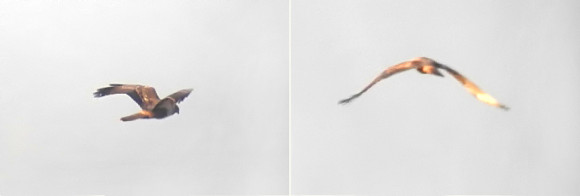Bird News from Nial Moores and Jason Loghry
In continuing settled, sunny and mild conditions (with a low of -1C and a high of +8C), a couple of hours at dawn and dusk at the Nakdong Estuary and the remainder of the day at Junam, where a third of the reservoirs’ surface remains unfrozen.
At the Nakdong Estuary, first highlight (lowlight!) before sunrise was an apparent fuscus-type Lesser Black-backed Gull sitting on the water with c.500 other gulls (NM only), Swaro-scoped at c. 150m range. Unfortunately it was seen only for 10 seconds at rest on the water and then through the ‘scope in flight for a further 15 seconds or so as the gull flock flew out of the estuary – and could not be re-found in the evening. There are no images and its identity must remain open to question. At rest, the bird was slightly smaller than Vega Gull, with a more elongated structure, recalling Taimyr Gull. The head showed some streaking on the nape and around the eye. Overall, there was only a very weak contrast between the primaries and the rest of the dark of the upperparts, and it was thus strikingly darker than 3-4 Slaty-backed, six or so Taimyr and c. 40 Black-tailed Gulls in direct comparison. In flight, there was a hint of a small mirror on P10, but the rest of the upperwing (with the exception of the secondary trail) simply looked dark, with no suggestion of a string of pearls or contrasting paler tongues in the primary black. The tail was clean white. The bill showed no obvious dark markings and the legs were not seen. Also in the estuary, in addition to 2000+ large gulls, 1000+ Whooper Swan, two Tundra Swan, two (presumed) Black-faced Spoonbill, between three and ten Swan Geese, 2-3 White-tailed Eagle, 2-3 Hen Harrier and rarest in the Korean context one First Calendar-year Steller’s Sea Eagle, one (NM) or two (JL) Eastern Marsh Harrier and two Relict Gull (one First-winter and one Second-winter).
At the Junam Reservoirs, no sign of the Siberian Chiffchaff found here 2-3 days earlier by Philippe Dubois, but instead excellent views of a diverse range of waterbirds including several hundred “large-end” middendorffi Taiga Bean Geese, five Baikal Teal, 30+ Falcated Duck, one Mandarin, four Swan Geese, 80+ White-naped and twoHooded Cranes. Rarest in the domestic context was a First-winter Mute Swan. The second ID curiosity of the day was provided by a presumed super-bleached immature White-tailed Eagle seen only in flight, initially down to 100m or so. It was poorly-digiscoped (at >1km range) as it started to soar. Unlike the two other White-tailed Eagle which were present – and more importantly unlike many hundreds seen over the years – this super-pale sea-eagle, although it seemed not obviously dissimilar to White-tailed in structure, had a dark head contrasting with an off-white breast and belly; white or off-white axillaries, with white extending across much of the greater coverts on the underwing; off-white back and upperwing coverts; and a tail which was a mix of white and dark, with a darker tail band. Unlike the gull earlier in the day, this distinctive-looking individual should be relatively easy to re-find!
 Eastern Marsh Harrier Circus spilonotus, © Nial Moores
Eastern Marsh Harrier Circus spilonotus, © Nial Moores
 Taiga Bean Goose Anser fabalis, © Nial Moores
Taiga Bean Goose Anser fabalis, © Nial Moores
 Taiga Bean Goose Anser fabalis, © Nial Moores
Taiga Bean Goose Anser fabalis, © Nial Moores


